- This topic has 21 replies, 4 voices, and was last updated 8 years, 9 months ago by
 Bill Ward.
Bill Ward.
-
AuthorPosts
-
3 December 2015 at 9:30 am #573509
 Bill WardParticipant
Bill WardParticipantHi,
The latest higher sensitivity WATEC cameras (the 910’s) have began to show meteors in a slightly new way.
Video observing shows a wide variety of effects, some meteors seem to flash into then out of existence whereas other are much slower. Recently, though, I’ve started to notice some that positively ooze out of existance. I’m sure these have always been there but the better performance of the new cameras gives a much better view of the effect.
I’ve put a recent capture on youtube at https://www.youtube.com/watch?v=-thc7_H4F6c
The meteor can seen to elongate and fade away. I’ve not processed it yet, but last night I captured another one that was so slow the video capture software stopped recording before it finally disappeared from view when it fell below the threshold of the motion filter.
I imagine there is a confluence of material properties and orbital parameters that causes the effect on a propotion of meteors. There is also the effect of double brightness peaking meteors. The video shows this effect too by co-incidence. This has been the subject of previous professional research but that was on a relatively small sample. I’ve already received information from other video observers who have kindly sent me some of their images. Definitely another interesting feature to explore.
Even after a decade of video observing there’s still new things to see!
Cheers,
Bill.
3 December 2015 at 11:36 pm #577169 Bill WardParticipant6 December 2015 at 4:58 pm #577171
Bill WardParticipant6 December 2015 at 4:58 pm #577171 Grant PrivettParticipant
Grant PrivettParticipantIs the camera doing any running stacking of the images in the background?
7 December 2015 at 9:19 pm #577172 Bill WardParticipant
Bill WardParticipantHi,
The 910 can do all sorts of onboard processing and summing but I just run them at the standard single exposure video rate.
Cheers,
Bill.
8 December 2015 at 6:12 pm #577173 Grant PrivettParticipant
Grant PrivettParticipantThere goes that theory 🙂
9 December 2015 at 9:46 am #577174 Bill WardParticipant
Bill WardParticipantHi Grant,
Perhaps not….
Whilst I haven’t “set” any parameters it might not necessarily mean that something I don’t know about may be going on. It’ll be interesting to double check just in case (As or when I ever get to see the sky again. Apart from some very short windows all it has done here is rain for week after week. Very depressing) 🙁
However as a more quantative look at the fade here is a light curve I made of the first one I reported. The rapid onset is quite typical but the slower decay is clearly seen. As commented, this particular meteor is also one of the multi brightness peak class that occur.
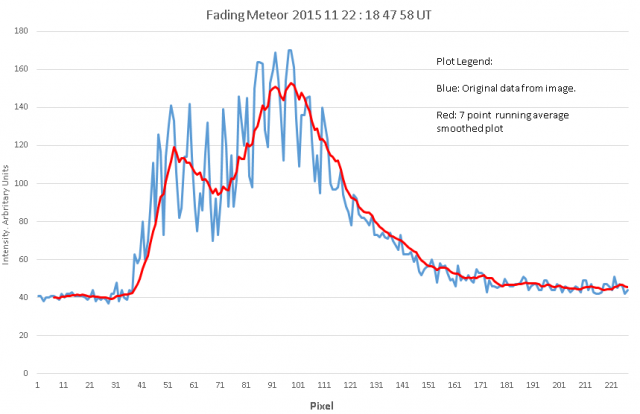
cheers,
Bill.
9 December 2015 at 9:33 pm #577175 David DunnParticipant
David DunnParticipantBill,
What SW do you use to plot the meteor intensity curve.
Many thanks
David D
10 December 2015 at 3:42 pm #577176 Grant PrivettParticipant
Grant PrivettParticipantSilly question: is the sensor interlaced and was a dark frame subtraction applied?
16 December 2015 at 1:54 pm #577181 Bill WardParticipant
Bill WardParticipantDavid,
The curve is generated very crudely with the “slice” function in iris. This is then saved as a text file with the relative intensities.
It is then dropped into either excel for a quick look, like this, or GNUplot for a more upmarket finish.
Grant,
Yes, the devices are interlaced. this is what generates the spikey appearence as the meteor moves.
And, no there is no dark subtraction. At video rates the noise level is already quite low so I’ve never bothered with it. The real problem is good flat fielding. That’s a different challenge!
cheers,
Bill.
16 January 2016 at 10:26 pm #577231 Bill WardParticipant
Bill WardParticipantHi,
Caught yet another “melting meteor”. These are definitley a subclass of meteoroid. The “fluffy dustballs”!
https://www.youtube.com/watch?v=eppOe5sJymk
Cheers
Bill.
19 January 2016 at 9:47 pm #577233 Bill WardParticipant
Bill WardParticipantHi,
Here’s a light curve generated from the latest “melting meteor”.
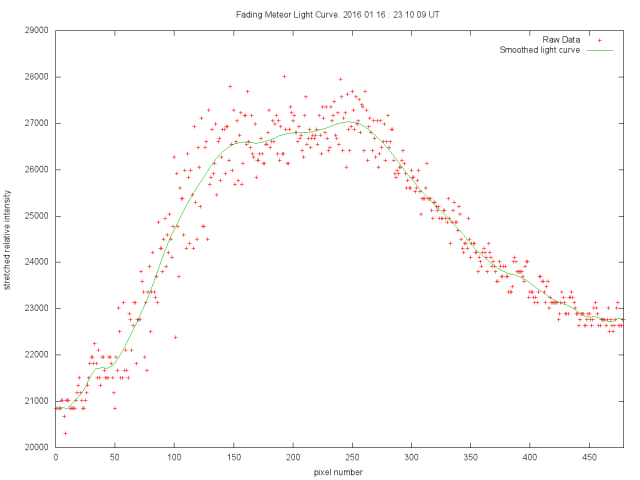
Interesting to compare this one to the one above. Maybe I should have drawn a longer “tail” on this one to make the comparison more direct. However one can see the same gentle tail off of light as the meteor disintegrates.
I’ll need to dig out some comparable brightness “regular” meteors to show how they have a steeper fall of of light, it’s on the to-do list… 😉
cheers,
Bill.
12 February 2016 at 12:37 pm #577254 Bill WardParticipant
Bill WardParticipantHi,
As promised… Captured another “slow fade” meteor and also another bright meteor to compare it to.
These were both caught with the same camera system on the same calendar day. (One was from the morning and the other early evening.)
Fading meteor composite image.
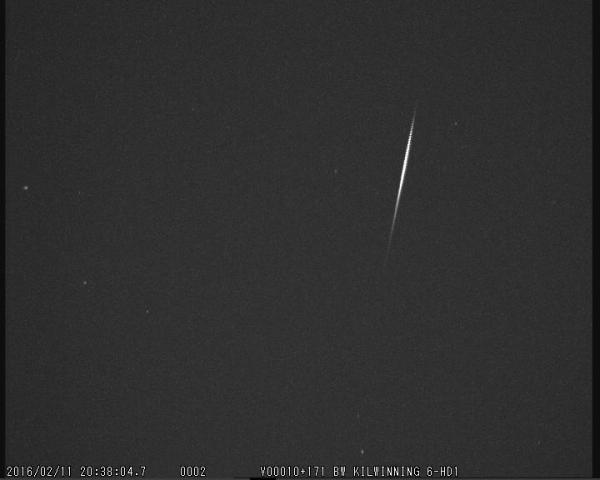
Fading meteor light curve
.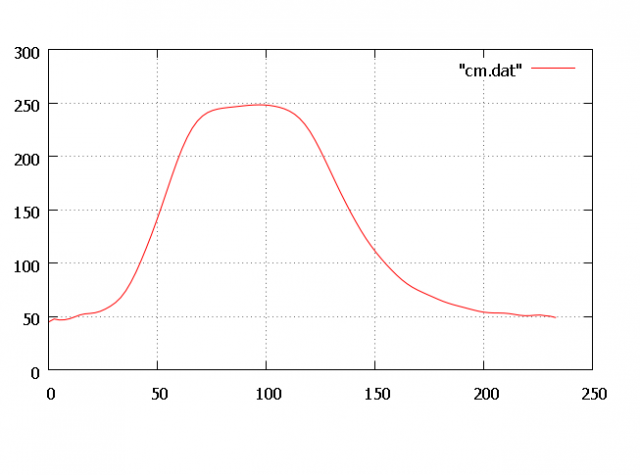
Comparison meteor composite image.
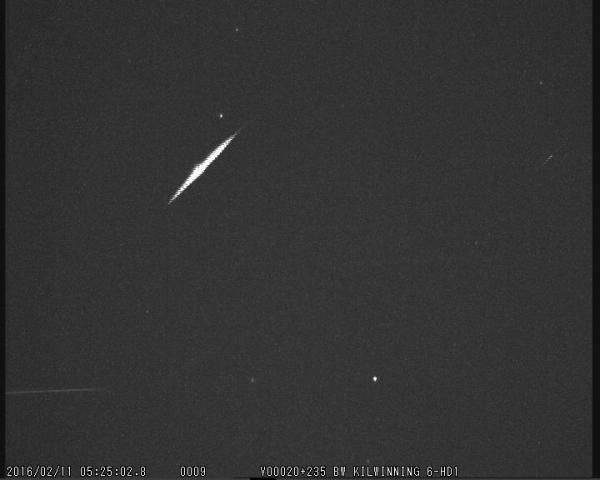
Comparison meteor light curve.
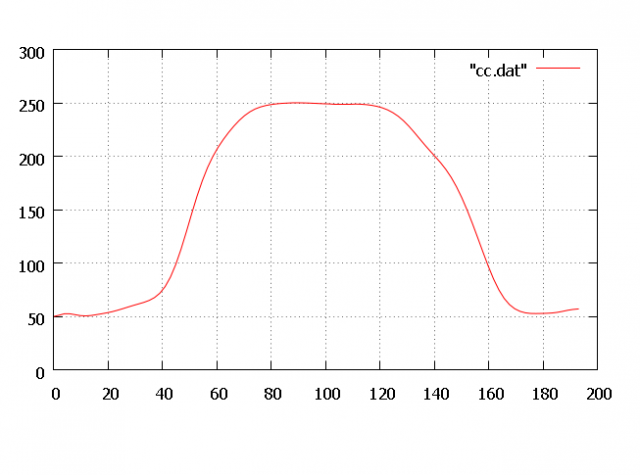
By using the slice function in IRIS smoothed curves were plotted showing the light curves.
Axes are simply x:pixel and y:rel intensity
It can be seen the onset is very similar, then the mechanics come into play. The ablation characteristics change and the meteors “burn out” quite differently.
The graphs show the more rapid decline of the comparison and the slower decline of the fading meteor, nice to see a measureable difference.
cheers,
Bill.
12 March 2016 at 12:22 am #577272 Bill WardParticipant
Bill WardParticipantHi,
Whilst reviewing the video’s from the last clear night I noticed one, that whilst not quite in the fading class, did appear somewhat unusual.
It looked like it was varying throughout it’s trajectory. Having watched the video several times I was convinced it was a real effect.
However when using the usual slice function all of the scan line artifacts pollute the image…
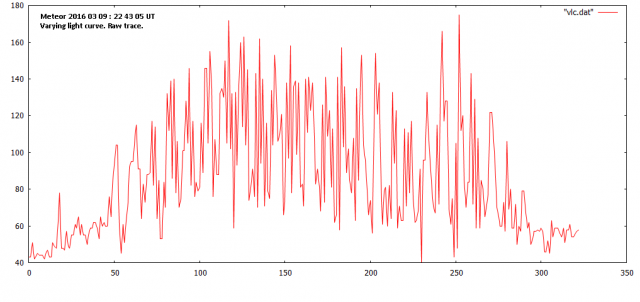
Not very pretty. But doing the Bezier smoothing on the graph reveals the effect quite clearly…
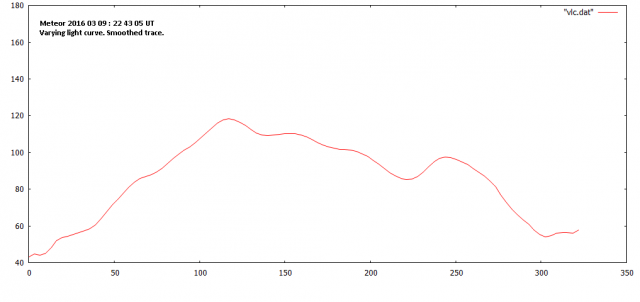
Working with the other meteor observers in the NEMETODE group has turned up quite a few double peaked meteor but I’ve never seen a meteor with this number of “peaks”. There are five definite “peaks” (and possibly another very weak one but the smoothing might be playing tricks here.)
Another interesting capture.
cheers,
Bill.
25 September 2016 at 10:18 pm #577496 Bill WardParticipant
Bill WardParticipantHi,
Here’s the light curve from meteor 20160924_232416 (and a spectrum). Light curve shows the distinct shape as illustrated in previous postings. Now just need more spectra to see if what the compositional traits are (orbits would be nice to see of it’s fluffy cometary stuff…)
Here’s the capture image that shows the zero order image plus weak spectrum.
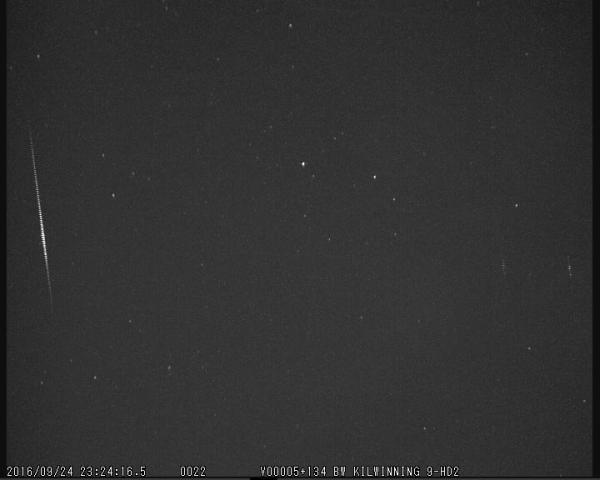
…and the smoothed light curve with the distinctive looking tail off like the other example.
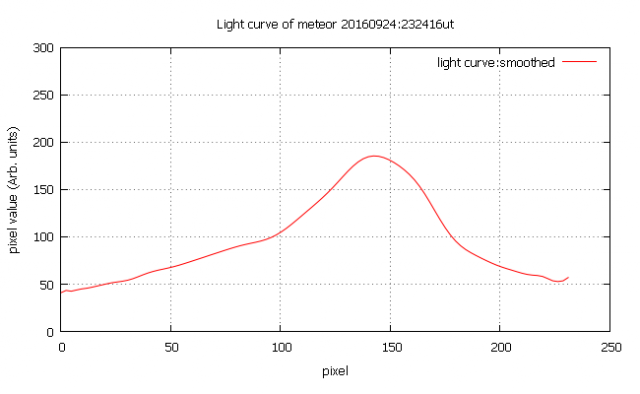
…also the spectra again, just in case…
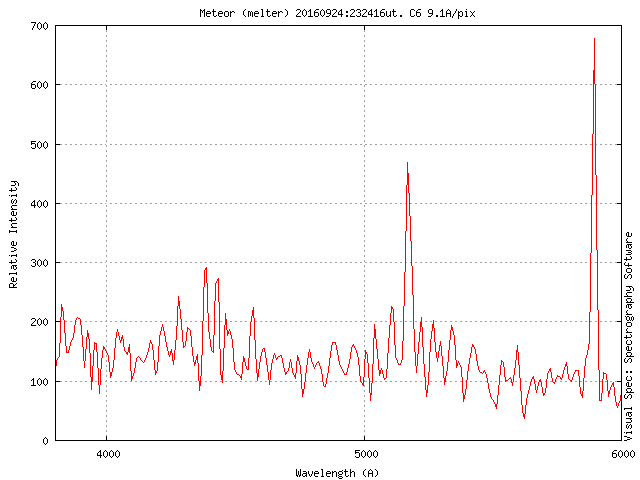
it’s all good stuff… 😉
cheers,
Bill.
17 November 2016 at 12:01 pm #577655 Bill WardParticipant
Bill WardParticipantThe fading meteors continue to be captured…
Got this last week. https://www.youtube.com/watch?v=YrxxiWbe40Q
First time I’ve seen this effect, most unusual.
cheers,
Bill.
21 November 2016 at 10:41 pm #577668 Jeremy ShearsParticipant
Jeremy ShearsParticipantThat’s a remarkable video, Bill. Certainly looks like the meteor separates.
Jeremy
22 November 2016 at 9:40 pm #577672 Bill WardParticipant
Bill WardParticipantHi,
Thanks, I initially wondered if this effect is what I have picked up in the more unusual spectra that show changes towards the end of flight.
…but perhaps not…I’ve been doing some crude velocity measurements and the separating part is travelling at more or less the same velocity (until burn out) as the pre separating meteor trail. So it looks like the meteoroid “sheds” some material, perhaps volatiles reaching a critical temperature and then taking some portion meteorid with it giving the little “puff” of stuff.
A spectrum would have been nice but it’s really nice to catch a new meteor ablation effect (unless anyone else has recorded it before…)
cheers,
Bill.
9 February 2017 at 11:37 am #577936 Bill WardParticipant
Bill WardParticipantOne observation is an oddity but two is the discovery of a previously un-noted class of meteor behaviour!
Caught a second separating meteor this morning. Fascinating. Having viewed several hundred video’s there a a few suspicious ones but this and the previous are by far the most definite.
7 March 2017 at 8:19 pm #578006 Bill WardParticipant
Bill WardParticipantThese “dissolving” meteors are proving to be fascinating…
In an attempt to better visualise the unusual ablation I’ve mounted 25mm lenses on a couple of cameras to give a larger image scale Unfortunately the corollary is a smaller field of view though ;-(
However caught this near perfect example of a melting meteor this morning.
The meteoroid must be fragmenting into a large number of extremely small particles to exhibit this behaviour. Even at this size they are still undergoing very rapid heating and evaporation. Just melting into the atmosphere!
cheers,
Bill.
7 March 2017 at 10:16 pm #578008 Jeremy ShearsParticipant
Jeremy ShearsParticipantThat’s a very interesting meteor video, Bill.
You are beginning to build a nice collection of these enigmatic objects.
Jeremy
-
AuthorPosts
- You must be logged in to reply to this topic.
